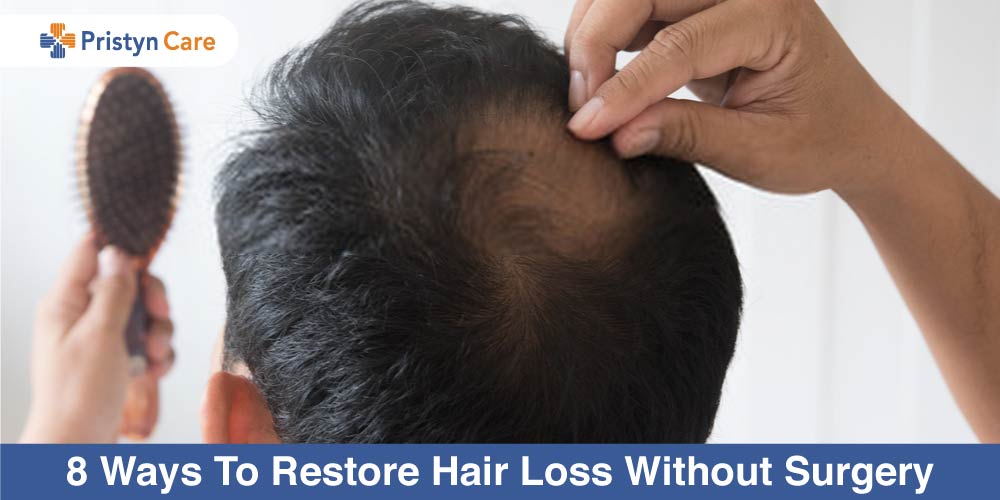
There are various treatment options for hair loss available in the market. But when it comes to surgery that offers the most effective results, people become skeptical. The fear of bruising and wounds gets the better of them.
This blog suggests 8 non-surgical options to consider to encourage hair growth and reduce that receding hairline.
Table of Contents
Medicines
The first and foremost non-surgical option to consider is medication. Fortunately, both these hair-loss medicines are approved by the United States Food and Drug Administration (USFDA). One can consider taking medicines for encouraging hair growth. Generally, doctors prescribe the following medicines-
Minoxidil- Initially used for the treatment of ulcers, this medicine can also treat enlarged prostate. When androgen, such as Dihydrotestosterone, attaches to the hair follicles that triggers inflammation. This inflammatory response makes it difficult for blood vessels to supply blood to the hair follicles resulting in the death of the tissue. Hence, this tissue death results in thinning and alopecia that in turn, leads to baldness. This medicine dilates the blood vessels allowing more blood to reach the follicles and therefore, prevent damage to follicles.
Finasteride– Unlike the above medicine, finasteride prevents the androgen from sticking to the hair follicles and resulting in inflammation. Unfortunately, this medicine can incur some side effects such as lower sex drive, erectile dysfunction. Furthermore, the side effects tend to continue even when the patient has stopped using it.
Healthy and Balanced Diet
Diet plays an integral role in making sure hair follicles grow from a bald area of the scalp. Proper nutrition ensures by following a healthy and balanced diet. There’s no need to skip on meals or follow an intense food regimen. The idea is simply to eat healthy! Here are some food items that the person should consider on a daily basis-
Leafy greens
Nuts and seeds
Whole grains
Seasonal fruits
Lean meatsMicroneedling
It is defined as a minimally invasive procedure that can trigger hair growth. With the advancement of technology, more and more people are opting for micro-needling. It works on the basis of collagen production when there is skin damage. Under this procedure, the doctor uses several small needles to prick the skin which in turn promotes the production of collagen. With each prick on the scalp, new cells grow. Although it is an absolutely safe procedure, the patient has to experience mild irritation and redness during the recovery.
Low-level Laser Therapy
This is a non-surgical option that can be tried at home also. Also known as red light therapy or cold laser therapy, doctors consider this procedure as a safe option. In this procedure, the doctor uses a probe that emits photons on the bald area that is absorbed by the weak hair follicles. This promotes hair growth. There are several advantages of undergoing this therapy- painless, noninvasive, almost nil side effects to name a few.
Scalp Tension Reduction Device
Primarily, scalp tension is the cause of hair loss. Hence, obviously reducing this tension can reduce hair fall. According to studies, people who used this device got relief considerably. The device makes a motion of inflation and deflation that causes the scalp to release and reduce the tension on the scalp. Hence, in turn, the device promotes hair growth.
Hair Replacement
A process of hair replacement entails stitching a base with hair follicles that acts as a tight membrane giving a more natural appearance of the hair. The hair follicles can be both natural as well as synthetic. This is a non-surgical procedure that is suitable for only people suffering from temporary hair loss. There are three steps of hair replacement-
Choosing the appropriate skin base from the range of various types such as skin, lace, polymer and monofilament.
Opting for the hair follicles in terms of texture, length, color that should be implanted on the base.
Choosing the ventilation options in the forms of knotting, injection and looping.
Read more: Difference between Hair replacement and Hair Transplant
Hair Platelet Rich Plasma
Another common procedure that people try is hair loss PRP. This is a three-step procedure that aims to treat hair loss with the patient’s own plasma. Here are three steps the patient needs to undergo-
The doctor takes a blood sample from the arm and puts it into a machine known as centrifuge.After a couple of minutes of centrifugation (a process of rapid spinning that separates fluids of different densities), the blood sample breaks into red blood cells and platelet-rich plasma.
The doctor takes the separated plasma in a syringe and injects it into the bald area.
The plasma stimulates the growth of new cells and strengthens existing hair follicles. Hence, there is hair growth.
Direct Hair Implantation or DHI
This is the most advanced type of hair transplantation. This is a day care procedure in which the hair follicles from the existing hair is taken using a specialized device to implant it into the receiving area. Some of the features of DHI are-
Hair follicles are shockproof which means they won’t fall during the recovery period. This gives a natural look of the overall head.
As it is a no-cut procedure, the patient is able to recover fast.
There is no visible scarring on the donor or receiving area.
Bloodless procedure as the doctor uses a specialized pen known as Choi to implant the follicles.
Conclusion
One can try various non-surgical options but none of them are as effective as the Hair loss PRP or DHI technique of hair implantation. The other methods may prove to be ineffective or even cause some severe side effects. At Pristyn Care, we offer both Hairfall PRP treatment and DHI technique for hair loss treatment. Book an appointment to know more.
Read more:







